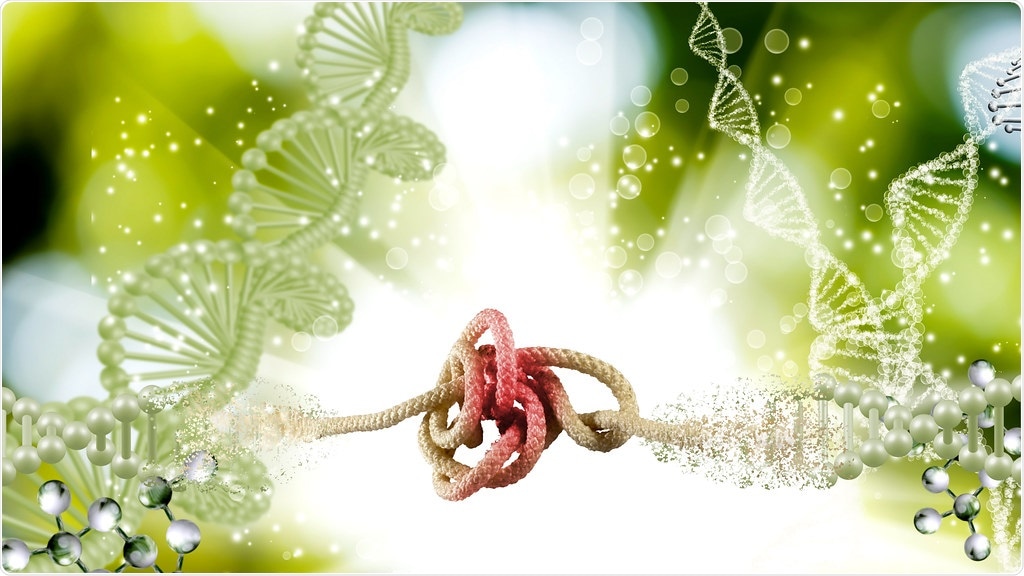Recent research carried out by the Milner Centre for Evolution at the University of Bath reveals that tangles in unwound DNA can develop mutational hotspots in the genomes of bacteria.

The evolution hotspots are caused by a tangle in the DNA that can disrupt the DNA replication machinery, resulting in mutations. Image Credit: Cooper.
The researchers of the study state that these findings would aid in foretelling the evolution of bacteria and viruses over time, in the future. It can also help engineer vaccine design and provide enhanced knowledge on antibiotic resistance.
The current research reveals that evolution is also influenced by tangles in the DNA strands, even though the majority of the evolution is shaped by natural selection—individuals adapted to their environment survive and transfer their genes. The research was published in the Nature Communications journal.
A group of researchers headed by the University of Bath in association with the University of Birmingham analyzed the evolution of two strains of the soil bacteria Pseudomonas fluorescens (SBW25 and Pf0-1).
The researchers eliminated a gene that helps the bacteria to swim. Both strains of the bacteria rapidly evolved the capability to swim again but utilizing dissimilar routes. One of the strains (named SBW25) mutated in the same region of a specific gene to restore mobility.
However, the other strain (named Pf0-1) mutated at various places in various genes every time the researchers repeated the tests.
The researchers compared the DNA sequences of the two strains to comprehend why one strain evolved predictably while the other was unpredictable. They identified that in the SBW25 strain, the one that mutated predictably, there is a region where the DNA strand looped back on itself developing a hairpin-shaped tangle.
These tangles are capable of disrupting the cell machinery, named DNA polymerase, which copies the gene at the time of cell division and hence causes mutations more likely.
The researchers eliminated the hairpin structure employing six silent mutations (without altering the sequence of the protein produced). This eliminated the mutational hotspot and the bacteria began evolving in numerous means to regain its swimming ability.
DNA normally forms a double helix structure, but when the DNA is copied, the strands are briefly separated. We’ve found there are hotspots in the DNA where the sequence causes the separated strands of DNA to get twisted back on themselves—a bit like when you pull apart the strands of a rope—this results in a tangle.”
Dr Tiffany Taylor, Milner Centre for Evolution, University of Bath
“When the DNA polymerase enzyme runs along the strand to copy the gene, it bumps into the tangle and can skip, causing a mutation. Our experiments show that we were able to create or remove mutational hotspots in the genome by altering the sequence to cause or prevent the hairpin tangle,” added Dr Taylor.
This shows that while natural selection is still the most important factor in evolution, there are other factors at play too. If we knew where the potential mutational hotspots in bacteria or viruses were, it might help us to predict how these microbes could mutate under selective pressure.”
Dr Tiffany Taylor, Milner Centre for Evolution, University of Bath
Mutational hotspots were identified in cancer cells earlier. The scientists intend to search for them across a wide range of bacterial species, including crucial pathogens.
This knowledge can aid researchers in better comprehending how viruses and bacteria, which in turn can help develop vaccines against new variants of diseases. The understanding also makes it easier to foretell how microorganisms develop resistance to antibiotics.
Like many exciting discoveries, this was found by accident. The mutations we were looking at were so-called silent because they don’t change the resulting protein sequence, so initially, we didn’t think they were particularly important. However, our findings fundamentally challenge our understanding of the role that silent mutations play in adaptation.”
Dr James Horton, Milner Centre for Evolution, University of Bath
Dr. James Horton recently completed his Ph.D. at the Milner Centre for Evolution.
Source:
Journal reference:
Horton, J. S., et al. (2021) A mutational hotspot that determines highly repeatable evolution can be built and broken by silent genetic changes. Nature Communications. doi.org/10.1038/s41467-021-26286-9.